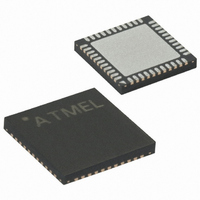ATMEGA162-16MC Atmel, ATMEGA162-16MC Datasheet - Page 102

ATMEGA162-16MC
Manufacturer Part Number
ATMEGA162-16MC
Description
IC MCU AVR 16K 5V 16MHZ 44-QFN
Manufacturer
Atmel
Series
AVR® ATmegar
Specifications of ATMEGA162-16MC
Core Processor
AVR
Core Size
8-Bit
Speed
16MHz
Connectivity
EBI/EMI, SPI, UART/USART
Peripherals
Brown-out Detect/Reset, POR, PWM, WDT
Number Of I /o
35
Program Memory Size
16KB (8K x 16)
Program Memory Type
FLASH
Eeprom Size
512 x 8
Ram Size
1K x 8
Voltage - Supply (vcc/vdd)
4.5 V ~ 5.5 V
Oscillator Type
Internal
Operating Temperature
0°C ~ 70°C
Package / Case
44-VQFN Exposed Pad
Lead Free Status / RoHS Status
Contains lead / RoHS non-compliant
Data Converters
-
- Current page: 102 of 289
- Download datasheet (3Mb)
Timer/Counter0,
Timer/Counter1, and
Timer/Counter3
Prescalers
Internal Clock Source
Prescaler Reset
External Clock Source
102
ATmega162(V/U/L)
Timer/Counter3, Timer/Counter1, and Timer/Counter0 share the same prescaler mod-
ule, but the Timer/Counters can have different prescaler settings. The description below
applies to Timer/Counter3, Timer/Counter1, and Timer/Counter0.
The Timer/Counter can be clocked directly by the system clock (by setting the CSn2:0 =
1). This provides the fastest operation, with a maximum Timer/Counter clock frequency
equal to system clock frequency (f
caler can be used as a clock source. The prescaled clock has a frequency of either
f
option of choosing f
The prescaler is free running, i.e., operates independently of the clock select logic of the
Timer /Counter , and it is shar ed by Ti mer/Co unter 3, Timer /Counter 1, a nd
Timer/Counter0. Since the prescaler is not affected by the Timer/Counter’s clock select,
the state of the prescaler will have implications for situations where a prescaled clock is
used. One example of prescaling artifacts occurs when the Timer is enabled and
clocked by the prescaler (6 > CSn2:0 > 1). The number of system clock cycles from
when the Timer is enabled to the first count occurs can be from 1 to N+1 system clock
cycles, where N equals the prescaler divisor (8, 64, 256, or 1024, additional selections
for Timer/Counter3: 32 and 64).
It is possible to use the Prescaler Reset for synchronizing the Timer/Counter to program
execution. However, care must be taken if the other Timer/Counter that shares the
same prescaler also uses prescaling. A Prescaler Reset will affect the prescaler period
for all Timer/Counters it is connected to.
An external clock source applied to the Tn/T0 pin can be used as Timer/Counter clock
(clk
every system clock cycle by the pin synchronization logic. The synchronized (sampled)
signal is then passed through the edge detector. Figure 44 shows a functional equiva-
lent block diagram of the Tn/T0 synchronization and edge detector logic. The registers
are clocked at the positive edge of the internal system clock (
parent in the high period of the internal system clock.
The edge detector generates one clk
ative (CSn2:0 = 6) edge it detects.
Figure 44. Tn/T0 Pin Sampling
The synchronization and edge detector logic introduces a delay of 2.5 to 3.5 system
clock cycles from an edge has been applied to the Tn/T0 pin to the counter is updated.
Enabling and disabling of the clock input must be done when Tn/T0 has been stable for
at least one system clock cycle, otherwise it is a risk that a false Timer/Counter clock
pulse is generated.
CLK_I/O
Tn
clk
T1
I/O
/clk
/8, f
T
0) for Timer/Counter1 and Timer/Counter0. The Tn/T0 pin is sampled once
CLK_I/O
D
LE
/64, f
Q
CLK_I/O
Synchronization
CLK_I/O
D
/16 and f
Q
/256, or f
CLK_I/O
CLK_I/O
T1
CLK_I/O
/clk
/32.
). Alternatively, one of four taps from the pres-
T
0
/1024. In addition, Timer/Counter3 has the
pulse for each positive (CSn2:0 = 7) or neg-
D
Q
clk
I/O
). The latch is trans-
Edge Detector
2513C–AVR–09/02
Tn_sync
(To Clock
Select Logic)
Related parts for ATMEGA162-16MC
Image
Part Number
Description
Manufacturer
Datasheet
Request
R

Part Number:
Description:
Manufacturer:
Atmel Corporation
Datasheet:

Part Number:
Description:
IC AVR MCU 16K 16MHZ 5V 44TQFP
Manufacturer:
Atmel
Datasheet:

Part Number:
Description:
IC AVR MCU 16K 16MHZ 5V 40DIP
Manufacturer:
Atmel
Datasheet:

Part Number:
Description:
IC AVR MCU 16K 16MHZ 5V 44-QFN
Manufacturer:
Atmel
Datasheet:

Part Number:
Description:
IC MCU AVR 16K 5V 16MHZ 44-TQFP
Manufacturer:
Atmel
Datasheet:

Part Number:
Description:
IC MCU AVR 16K 5V 16MHZ 44-QFN
Manufacturer:
Atmel
Datasheet:

Part Number:
Description:
MCU AVR 16KB FLASH 16MHZ 44QFN
Manufacturer:
Atmel
Datasheet:

Part Number:
Description:
MCU AVR 16KB FLASH 16MHZ 44TQFP
Manufacturer:
Atmel
Datasheet:

Part Number:
Description:
IC MCU AVR 16K 5V 16MHZ 44-TQFP
Manufacturer:
Atmel
Datasheet:

Part Number:
Description:
IC MCU AVR 16K 5V 16MHZ 40-DIP
Manufacturer:
Atmel
Datasheet:

Part Number:
Description:
IC MCU AVR 16K 5V 16MHZ 40-DIP
Manufacturer:
Atmel
Datasheet:

Part Number:
Description:
IC MCU AVR 16K 5V 16MHZ 44-TQFP
Manufacturer:
Atmel
Datasheet:

Part Number:
Description:
IC MCU AVR 16K 5V 16MHZ 44-QFN
Manufacturer:
Atmel
Datasheet:










